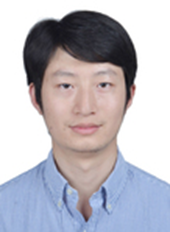|
| Tian Ye Address: Zhenjiang Building, Xianlin Campus Email: ytian@nju.edu.cn Personal website: http://www.tian-bionano.com/ |
| Research Field: DNA nanotechnology; DNA origami; Self-assembly of DNA structures and functional nanomaterials; Bionano-optics; Nano-sensor; Drug delivery; Electrical materials; multifunctional catalytic. Profile: Ye Tian, a professor and doctoral supervisor, was the Innovative and Entrepreneurial Talent in Jiangsu province, and on the Recruitment Program of Global Experts. He was successively engaged in research in Columbia University and Brookhaven National Laboratory. Now he is working at the Department of Materials Science and Engineering, College of Engineering and Applied Sciences, Nanjing University, while he is a double-employed PI of Chemistry and Biomedicine Innovation Center, Nanjing University. He is also a researcher at the State Key Laboratory of Analytical Chemistry for Life Science, School of Chemistry and Chemical Engineering, Nanjing University, and Jiangsu Key Laboratory of Artificial Functional Materials, Nanjing University. Professor Tian has made important research achievements in the fields of nucleic acid materials, DNA nanotechnology, DNA origami technology, ordered and controllable self-assembly of colloidal particles, construction of colloidal three-dimensional superlattice system, plasmonic effects of colloids and their applications. His works were published in the top international journals such as Nature Materials, Nature Nanotechnology, Nature Chemistry, Angew. Chem. Int. Ed., Nano Letters, and ACS Nano, which exerted great academic influence both at home and abroad, and the relevant research has been published or interviewed by domestic and foreign scientific media for more than 30 times. Professor Tian’s research focuses on the self-assembly of nanomaterials by DNA nanotechnology and their applications in electronic and optical devices; construction of photocatalysis, electrocatalysis, photocatalysis systems with morphology and components controlled in microscale; preparation of functional materials and research on their related electrical/battery properties; the targeting treatment of tumor cells by DNA nanotechnology, and atomic manufacturing basing on DNA origami. Selected Publications: (Note: # refers to equal contributor) (1) M. Wang, L. Dai, J. Duan, Z. Ding, P. Wang, Z. Li, H, Xing, Y. Tian*, Programmable Assembly of Nano-architectures through Designing Anisotropic DNA Origami Patches. Angewandte Chemie-International Edition, 2020, 59(16): 6389; (2) Y. Tian, J. R. Lhermitte, L. Bai, et al, Ordered three-dimensional nanomaterials using DNA-prescribed and valence-controlled material voxels. Nature Materials, 2020, DOI: 10.1038/s41563-019-0550-x; (3) X. Xin, L. Wang, K. Wang, L. Dai, H. Cao, Z. Li, Y. Tian*, Stepwise assembly of nanoclusters guided by DNA origami frames with high-throughput. Chemical Communications, 2020, 56(36): 4918; (4) N. Ma, B. Minevich, J. Liu, M. Ji, Y. Tian*, O. Gang, Directional Assembly of Nanoparticles by DNA Shapes: Towards Designed Architectures and Functionality. Topics in Current Chemistry, 2020, 378(2): 36; (5) H. Zhang, M. Li, K. Wang, Y. Tian, et al, Polarized Single-Particle Quantum Dot Emitters through Programmable Cluster Assembly. ACS Nano, 2020, 14(2), 1369; (6) M. Ji, N. Ma, Y. Tian*, 3D Lattice Engineering of Nanoparticles by DNA Shells. Small, 2019, 15(26): 1805401; (7) Z. Sun, Y. Tian, W. L. Hom, O. Gang, S. R. Bhatia, R. B. Grubbs, Translating Thermal Response of Triblock Copolymer Assemblies in Dilute Solution to Macroscopic Gelation and Phase Separation. Angewandte Chemie-International Edition, 2017, 56(6): 1491; (8) Y. Tian, Y. Zhang, T. Wang, H. L. Xin, H. Li, O. Gang, Lattice engineering through nanoparticle–DNA frameworks. Nature Materials, 2016, 15(6): 654; (9) W. Liu, J. Halverson, Y. Tian, A. V. Tkachenko, O. Gang, Self-organized architectures from assorted DNA-framed nanoparticles. Nature Chemistry, 2016, 8(9): 867; (10) Y. Tian#, T. Wang#, W. Liu, H. L. Xin, H. Li, Y. Ke, W. M. Shih, O. Gang, Prescribed nanoparticle cluster architectures and low-dimensional arrays built using octahedral DNA origami frames. Nature Nanotechnology, 2015, 10(7): 637; (11) D. Sun#, Y. Tian#, Y. Zhang, Z. Xu, M. Y. Sfeir, M. Cotlet, O. Gang, Light-Harvesting Nanoparticle Core-Shell Clusters with Controllable Optical Output. ACS Nano, 2015, 9(6): 5657; (12) F. Lu#, Y. Tian#, M. Liu, D. Su, H. Zhang, A. O. Govorov, O. Gang, Discrete Nanocubes as Plasmonic Reporters of Molecular Chirality. Nano Letters, 2013, 13(7): 3145; Graduate Student Advisement Each year, Professor Tian recruits 1 or 3 doctoral students (including bachelor-straight-to-doctorate students and successive master-doctorate students, 3 master’s students and 2 or 3 undergraduate students. Professor Tian and his team would like to employ a certain number of post-doctoral researchers or full-time researchers. Priority is given to applicants with research experience in DNA nanotechnology, analytical chemistry, optics, nanomaterial synthesis and characterization, crystallography, catalysis, physicochemical deposition, biochemistry, and supramolecular chemistry and assembly. Specific salary negotiable (post-doctoral basic salary of 200,000 to 300,000, associate researcher from 400,000). Email: ytian@nju.edu.cn
| |


